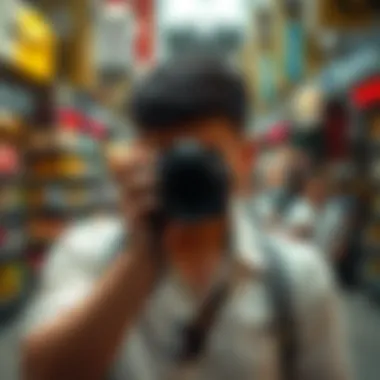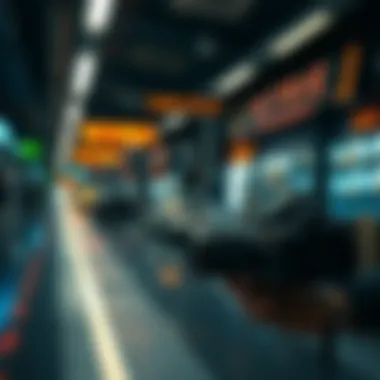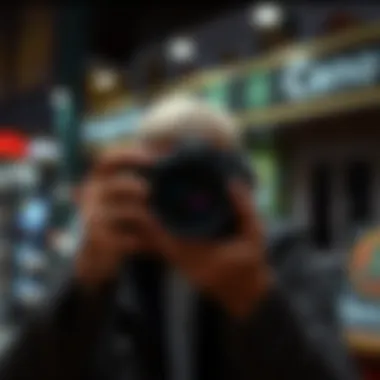Navigating the Photography NFT Marketplace


Intro
In the shifting sands of the digital art world, photography NFTs, or non-fungible tokens, stand out as a beacon of transformation. For those not in the know, NFTs allow photographers to authenticate their digital works on the blockchain, a technology that’s shaking things up across various sectors. Blockchain provides an immovable ledger that confirms ownership and provenance, which is particularly crucial in an age where digital reproduction is rampant.
The photography NFT marketplace has expanded rapidly, presenting both new opportunities and unique challenges for creators and collectors. As the barriers to entry lower, the landscape remains fraught with complexities, touching on legal, financial, and ethical considerations. Photographers looking to dive into this realm must navigate not just the creation of their digital works but also how these pieces are presented, marketed, and, ultimately, valued.
This exploration does not stop with the artists. Collectors, and even casual enthusiasts, are drawn into this vivid digital bazaar, where a single photograph can fetch prices that rival traditional art forms. The intersection of art and technology raises questions about what constitutes value, prompting a rethinking of traditional concepts tied to photography.
In this article, we will peel back the layers of the photography NFT market while investigating the processes behind the scenes. We'll cover essential trends in cryptocurrency that are relevant to this sector, delve into educational aspects of blockchain, and provide insights that can benefit both photographers and those interested in this innovative market.
As we move forward, our journey will take us through the mechanics of trading photography NFTs; understanding the emerging technologies that enrich this space; and how best to ensure that investments in this rapidly evolving arena are handled with care and acumen. Let's embark on this enlightening odyssey into a future where photos take on a new life in the digital economy.
Understanding NFTs in the Context of Photography
In recent years, the concept of NFTs, or non-fungible tokens, has seen an explosive rise, particularly within the art world. When discussing photography, NFTs provide a framework that shifts how we consider ownership and value in the digital space. This section delves into essential components of NFTs as they pertain to photography, underscoring their significance for both artists and collectors alike.
Defining NFTs
So, what exactly are NFTs? To put it simply, NFTs are unique digital assets verified using blockchain technology. Unlike cryptocurrencies such as Bitcoin or Ethereum, which are fungible, NFTs are one-of-a-kind. Each NFT carries distinct information and cannot be replaced with another one.
When it comes to photography, the notion of a physical print being transferred into a digital format adds layers of complexity. Photographers can tokenize their work, creating a digital certificate of authenticity that serves as proof of ownership. This innovation creates a new pathway for selling art, ensuring artists receive due recognition and compensation for their work.
The Intersection of Photography and Blockchain
The melding of photography and blockchain technology has opened up new avenues for creatives. For many photographers, especially emerging ones, the traditional gallery model can be daunting and often excludes lesser-known talents. Blockchain acts as an equalizer by eliminating intermediaries. Photographers can directly sell their digital artworks to buyers, maintaining a better grasp on their profits and creative rights.
The decentralized nature of blockchain allows for transparent records of ownership, which is a game changer in a field that often struggles with copyright issues. By anchoring their work on the blockchain, photographers can accurately track their pieces and ensure their intellectual property remains protected.
Benefits of NFTs for Photographers
The introduction of NFTs into the photography realm brings with it several notable benefits:
- Ownership Clarity: NFTs enable clear definitions of ownership rights and help to combat the popularity of image theft, which plagues many photographers.
- Residue Royalties: Many NFT platforms offer a feature where artists can earn royalties each time their work gets resold. This model further incentivizes photographers, ensuring they continue to benefit from their creations long after the initial sale.
- Accessibility: The NFT marketplace is globally accessible; anyone with an internet connection can potentially purchase art from talented photographers around the world, increasing exposure for creators.
- Community Engagement: NFTs invite a culture of community support. Photographers can connect with collectors and fellow artists, creating an engaged audience that appreciates their work.
"In the evolving landscape of digital art, understanding NFTs is not just beneficial; it's essential for survival and success."
For further reading on this topic, consider exploring Wikipedia or Britannica to deepen your foundation in NFTs and their applications.


The Mechanics of the Photography NFT Marketplace
Understanding how the photography NFT marketplace operates is crucial for artists and collectors alike. This section provides a clear lens on the specific components that enable NFTs to thrive in the sphere of photography, emphasizing the processes and considerations behind market transactions. Whether you're an artist looking to sell your works or a collector aiming to invest, gaining insight into these mechanics lays the groundwork for smart decision-making.
How the Marketplace Functions
To grasp the nitty-gritty of photography NFTs, one first needs to understand the underlying technology that powers them: blockchain. The marketplace operates on blockchain networks, where each transaction creates a unique, immutable record. Whenever a piece of photography is converted into an NFT, it is registered on the blockchain. This ensures ownership and authenticity, allowing artists and buyers to trust in the validity of their transactions.
The marketplace typically comprises various platforms, each serving as a digital gallery where photographers can showcase their works. Users can browse, purchase, and sell NFTs, with the backing of smart contracts that automatically enforce the terms of the sale without any middleman interference. This system empowers artists by providing a direct line to their audience while keeping transaction costs low.
Navigating NFT Marketplaces
Navigating the plethora of NFT marketplaces can feel similar to wandering through a labyrinth, given the sheer volume of platforms available. Each has its own nuances and typical user base.
Popular Platforms Overview
When it comes to popularity, platforms like OpenSea, Rarible, and Foundation dominate the scene.
- OpenSea: Often reffered to as the Amazon of NFTs, this platform hosts a diverse range of digital art including photography. Its vast user base contributes to a lively marketplace where buyers and sellers frequently interact. The open nature of OpenSea allows budding photographers to dive in without facing steep entry barriers.
- Rarible: Unlike just being a marketplace for others, Rarible is a community-driven platform. It allows creators to mint their NFTs while earning royalties on secondary sales. This encourages greater artist engagement, making it a popular choice for photographers looking to build their reputation within a supportive environment.
Each platform offers its unique features and operational styles, which can either be beneficial or pose challenges based on user preferences.
Key Features and Functions
Understanding the key features of these marketplaces is paramount. For instance, community engagement in Rarible showcases user governance, where NFT holders can vote on platform changes. This can greatly influence how photography NFTs evolve in the future.
Another essential element is royalty structures. Many platforms implement systems that ensure artists receive a percentage of sales whenever their work is resold, thus allowing them to benefit in the long run.
While the minimal transaction costs are appealing, artists should also consider the fluctuation in platform popularity. For instance, a surge in users on one platform can lead to high competition, which can drive prices down for individual works. Conversely, lesser-known platforms may charge higher fees or attract fewer buyers.
Creating and Minting Photography NFTs
Creating and minting a photography NFT involves several steps, starting from the selection of the piece to indeed uploading it on a chosen platform. It's more than just a click of a button; it requires an understanding of file types, dimensions, and the significance of unique metadata. A photographer should ensure their work stands out amidst an ocean of digital art to capture potential buyers’ attention.
Minting can be as simple as following guided procedures provided by platforms, but the real test lies in marketing the new NFT.
In summation, grasping the mechanics of the photography NFT marketplace not only reveals the opportunities that lie in wait for photographers but also frames the risks and responsibilities that come with digital ownership. The clearer this relationship becomes, the better equipped artists and collectors can be to thrive in this evolution of the art world.


Economic Implications of Photography NFTs
The rise of NFTs has significantly transformed the economic landscape for photographers. This section will delve into various aspects surrounding the economic implications brought about by these digital assets, ensuring that artists and collectors alike understand the nuances.
Valuing Photography in a Digital Domain
One primary concern for photographers venturing into the NFT space is establishing the value of their work. Unlike traditional photography, which has a well-known market history, digital photography lacks such a concrete framework. Photographers must now consider multiple factors when pricing their NFTs. For instance, the uniqueness of each piece, the artist's reputation, and the emotional connection potential buyers may have with the image all contribute to its value.
To illustrate, imagine a photograph capturing a pivotal moment in a protest. Such an image might hold significant emotional weight and historical relevance, thus increasing its value. Add to this, if the photographer is known for their impactful work in social justice, the demand could skyrocket. Thus, understanding how to set a price that reflects both the artwork's significance and market trends is vital.
"In the digital realm, the perception of value can shift as rapidly as trends on social media."
Market Trends and Consumer Demand
Current trends indicate that consumer demand for photography NFTs is growing. People are not only seeking to own unique pieces but are also investing in them as an asset. High-profile art sales have demonstrated this shift, with some photography NFTs selling for staggering sums. It can be observed that collectors are turning towards assets they believe will appreciate in value over time.
Moreover, platforms like Foundation and MakersPlace are emphasizing limited editions, which create a sense of scarcity. This scarcity, in turn, pushes collectors to act quickly, often leading to bidding wars. Many buyers see NFTs as a hedge against inflation or even as a form of digital memorabilia. As societal values evolve, so does the appetite for investing in digital art, thereby driving the market trends forward.
Impact on Traditional Photography Sales
The introduction of NFTs has also cast a shadow over traditional photography sales. Photographers who once relied on galleries or physical exhibitions are now finding a new model that potentially reaches a broader audience. While this could seem like a threat to traditional sales, it can also be viewed as a complementary advancement.
For instance, a photographer might still sell prints through traditional channels but use NFTs to engage a different consumer demographic passionate about digital art. In some cases, successful photographers have even found that their NFT sales drive interest in their physical works—this cross-pollination can lead to a broader brand identity.
Yet, challenges persist. The unpredictability of the NFT market means traditional photographers must adapt to a landscape filled with volatility. They need to assimilate into a space where success is defined by online presentation and digital marketing, a shift that not every established photographer may be ready to tackle.
Challenges and Considerations
When discussing photography NFTs, it’s crucial to address the challenges and considerations that come with this innovation. While the potential for enhancing value and reach in the digital realm is significant, it’s equally important to navigate the associated hurdles. These challenges can shape the trajectory of an artist's career and influence collector behavior, thus making them essential in understanding the overall dynamics of the NFT market.
Understanding Copyright and Ownership
In the realm of photography, copyright and ownership are not just legal terms but pivotal concepts that shape how photographers operate. When artists enter the NFT space, they must grapple with the complexities of intellectual property. Buying an NFT does not automatically confer copyright ownership. Instead, the original creator typically retains this right unless explicitly transferred.
This reality raises several questions. For instance, what rights does the collector have? Can they display the image publicly? The price of NFTs can sometimes reflect not just the artistry but also the legal rights attached. Clear communication between creators and buyers can help prevent misunderstandings and ensure both parties know what’s at stake in the transaction.
Additionally, the digital nature of NFTs can complicate the traditional notions of copyright. For example, a photographer may produce a limited edition of an image in NFT form, but will the buyer respect that limitation or attempt to replicate and sell unauthorized copies elsewhere? This balance of trust and legal boundaries is pivotal.


Environmental Concerns of Blockchain Technology
The environmental implications of blockchain technology cannot be dismissed. As NFT transactions often require substantial energy consumption due to the proof-of-work systems many blockchains rely on, the carbon footprint associated with minting and trading NFTs can be considerable. This dilemma places creators and collectors in a tough spot: how to support innovation in digital art while being conscious of its ecological impact.
Reports suggest that a single transaction can emit more carbon than the average person in several countries generates in a week. Photography, a medium celebrated for capturing the beauty of the natural world, now faces a paradox as its digital counterpart may contribute to environmental harm.
Many are advocating for greener alternatives, such as proof-of-stake protocols, which are designed to be less energy-intensive. Photographers and collectors alike are beginning to prioritize platforms that actively seek to mitigate their carbon footprints. By targeting marketplaces that align sustainability with artistry, the community can contribute to a more ethical approach to NFTs.
The Risk of Speculation and Volatility
The photography NFT market is currently a hotbed for speculation. While some collectors aim to appreciate the art itself or support their favorite photographers, many view NFTs as mere investment vehicles. This brings with it a wave of volatility that can shape the market's health.
Prices can fluctuate dramatically based on trends, celebrity endorsements, and overall market sentiment. For instance, a photograph that sells for a startling sum one week might be dramatically devalued the next. This unpredictability poses a risk not only for investors but for photographers relying on the sale of their work for their livelihoods.
Ultimately, the key is moderation. While the excitement of potential profits can be alluring, understanding that the market can turn on a dime is crucial. Buyers ought to approach purchases with an eye for artistic worth and emotional connection rather than just the speculative potential.
Future Prospects for Photography in the NFT Space
The realm of photography is undergoing a metamorphosis, with NFTs playing a pivotal role in shaping its future landscape. As digital art and photography become ever more intertwined, understanding the prospective developments within the NFT marketplace is crucial. This section delves into emerging technologies that will redefine the medium, the community-building opportunities for photographers, and the potential for integration with other digital assets.
Emerging Technologies and Innovations
Innovations in technology are relentless, elevating the photography NFT sector to new heights. Beyond just ownership verification, upcoming advancements promise to enhance user experience and engagement. For instance, AI-driven tools could significantly simplify the creation and minting process of NFTs. Think about tools that can automatically curate and tokenize work based on an artist's previous styles, preferences, and audience response.
In addition to AI, augmented reality (AR) and virtual reality (VR) technologies are set to take center stage. Imagine viewing a photographic NFT in a virtual space where the viewer can interact with the image on a deeper level. Such experiences can develop a more immersive art interaction—where viewers aren’t just passive participants but rather active engageers.
Other platforms are also exploring innovative smart contracts. Smart contracts can automate royalties or even create tiered access for collectors, according to their investment levels. This could lead to a more personalized experience, where consistency in ownership is highlighted without sacrificing artistic expression.
Potential for Community Building among Photographers
Photographers have always thrived in communities, often exchanging knowledge, showcasing work, and building networks. The NFT space is giving rise to a unique community dynamic. With social media platforms and marketplaces adapting, photographers can congregate in dedicated forums and participate in NFT exhibitions. The idea of sharing insights in real-time cannot be overstated. It's not just about selling art; it’s about sharing ideas—an eclectic mix of techniques, styles, and philosophies.
Collaborative projects are also emerging, where groups of photographers contribute to collective NFT sales. This can significantly lower the financial barrier for entry, allowing those who may have previously hesitated to engage with NFTs now to participate. Moreover, platforms like Discord and Reddit will likely serve as hubs where photographers can connect, support each other, and explore future projects together.
"A singular photographer may be talented, but together, we can recreate entire worlds."
Integration with Other Digital Assets
As the digital landscape evolves, so does the notion of value extending into interconnected realms. Photographic NFTs can be amalgamated with other digital assets such as music, gaming, or branding. For instance, photographers could license their works alongside soundtracks, creating richer multimedia experiences. This strategy not only serves photographers but allows for cross-pollination in creative industries, ensuring all involved gain more exposure and potential revenue.
Furthermore, the concept of fractional ownership is increasingly gaining traction. By allowing multiple users to own shares of high-value NFTs, photographers could unlock new revenue streams while collectors gain access to works that were otherwise financially out of reach. This opens new doors not only for artists but also for collectors looking to diversify their portfolios.
In summary, the future of photography in the NFT space is ripe with possibility. From technological advancements to the fostering of a vibrant community, and the integration with diverse digital assets, photographers will find numerous avenues to explore and innovate. The path forward is not merely about selling digital art but redefining value and engagement in the ever-changing digital ecosystem.















